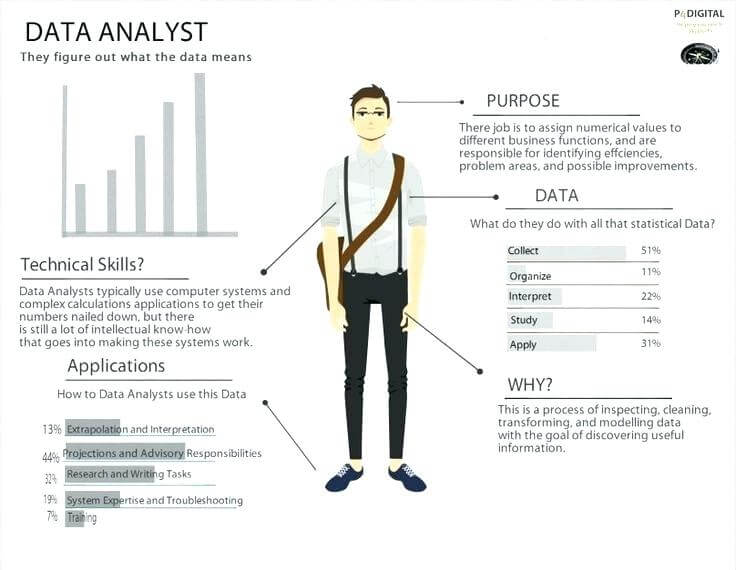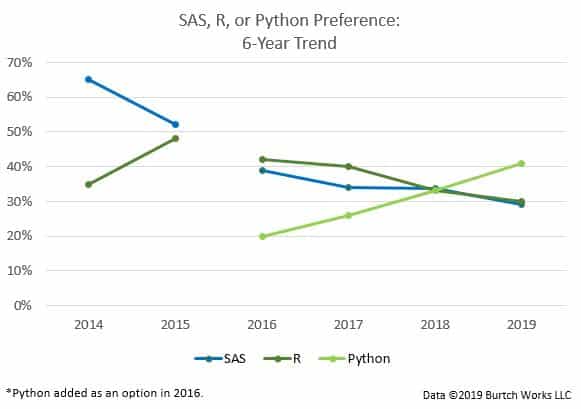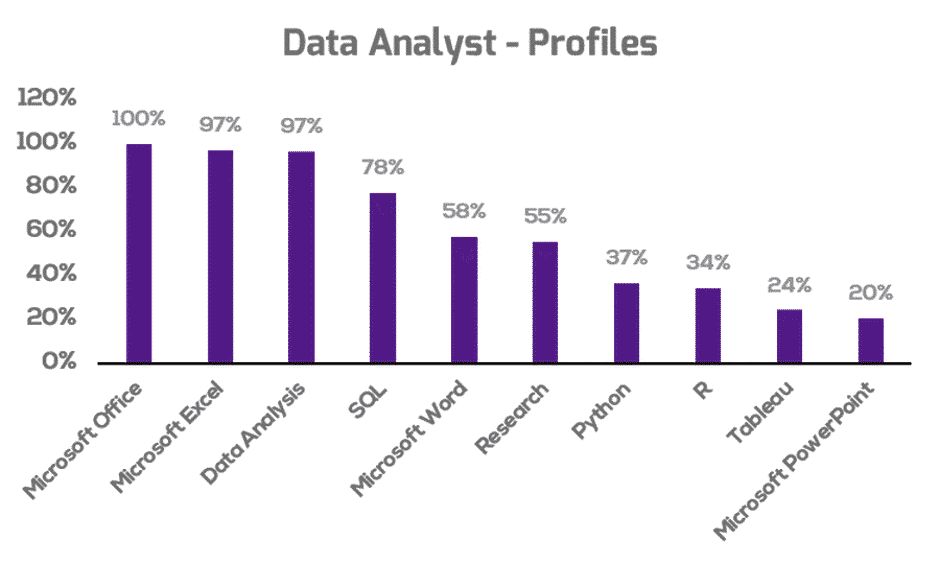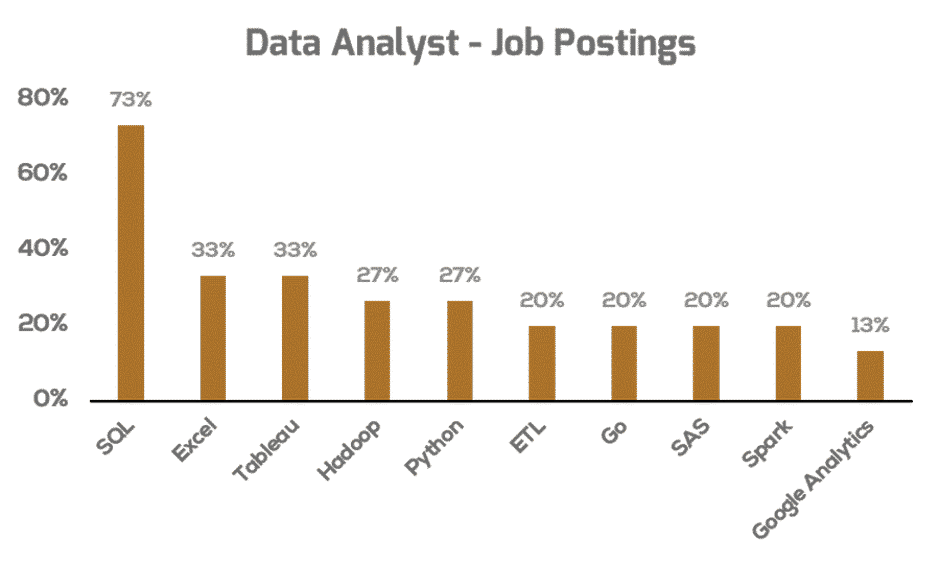Data Analysts have been around for years. However, the demand for this role is making headlines again in 2020. In this article, we take a look at why this is and help to ascertain what a Data Analyst really is in 2020.
Demand for Data Analysts is Skyrocketing
We’ve seen a growing trend among QuantHub clients. They’re ramping up hiring assessments for Data Analyst positions. One reason for this could be that they’re targeting a broader base of candidates in the hopes of widening their talent sourcing pool for data science teams.
Another reason could be that sometimes a Data Analyst is viewed as the “cheap” version of a Data Scientist. Companies might think that an analyst could be hired for a lower salary and taught data science skills and methods on the job. Could these be the reasons for increased interest in Data Analysts?
We think not. It’s more likely that the role of Data Analyst has finally become ubiquitous across industries and companies of all sizes.
Why is this? Whereas a decade ago data used to be gathered up solely by individuals for analysis, today it is gathered and collected by both people and machines. Now the machines do more and more gathering every day, so more and more people are needed to manage and make sense of all this data. Data Scientists alone can’t do this job anymore. Plus, they’re expensive.
Because of this phenomenon, we’re seeing the rise of the Data Analyst and the need for data literacy skills. Many studies, in fact, predict this role to be THE job of the future.
In 2018 the World Economic Forum published its predictions for the future workforce through 2022. In it, the WEF identified that by 2022, 85% of companies will have adopted big data and analytics technologies. WEF also found that 96% of companies were definitely planning or likely to plan to hire new permanent staff with relevant skills to fill future big data analytics related roles.
As a result, the “new role” of Data Analyst is forecast to be one of the most in-demand jobs by 2022. Since then, other sources such as LinkedIn, Glassdoor, US Bureau of Labor and Robert Half have confirmed this to be the case as well.
What is a Data Analyst?
The title “Data Analyst” may be more used and abused than that of its cousin the “Data Scientist”. For starters, a Data Analyst often holds a slightly different title such as Business Analyst or Business Intelligence Analyst. Depending on the company, these may or may not be the same person or role. Regardless of the actual title and the subtle differences between these roles, a “Data Analyst” is essentially someone who uses data to generate insights for an organization.
The Data Analyst’s responsibilities and role will be slightly different depending on the industry, type of organization and department in which they work. Typically they provide information that enables companies to define things such as products to be offered to customers according to their needs, marketing strategies to adopt, or the improvements to be made to manufacturing and production processes. In today’s world if you’re looking to make use of your data then you need a Data Analyst or two or three.
What Does a Data Analyst Do?

A general summary of what a Data Analyst does (Source: Shumpeioe.info)
Whether you’re a candidate looking to work as an analyst or a growing company looking to make use of big data, this is probably a question you have. With so many Data Analyst job descriptions out there and everybody wanting to get a handle on their big data analytics, it can be hard to settle on what exactly a Data Analyst does all day.
The picture above gives you a good start. It can be helpful to think of a Data Analyst as the person who helps business users answer business questions by developing charts like the one in the picture above.
A Data Analyst’s work will, first of all, vary both according to the type of department they work in, such as Sales or Finance, and the types of projects they are asked to work on. Generally, a Data Analyst’s job is to retrieve and collect data, organize it. They then use it to find correlations and patterns that produce meaningful conclusions relevant to the business. They essentially sift through business numbers and data and report what “stories” this information is hiding.
Data Analyst responsibilities include processing, cleaning and assembling data in databases according to business user (i.e. CFO or Sales Manager) requirements. They often work with Business Analysts (in this case, a separate and different role) who procure the information they need to help the business make decisions from the Data Analysts. To this effect, Data Analysts spend a lot of time developing systems for collecting the data and compiling data into reports.
Core Data Analyst Skills
Data analytics bachelor degree programs have exploded
to try and meet the forecast demand for Data Analysts. MBA programs, sports management, finance and accounting degree programs are starting to incorporate data analytics into their curriculum, too. Data Analyst certification programs from companies such as Cloudera and Dell EMC are now available.
So, then what are the core skills that anyone graduating with a related degree must have?
Data Analysts must, of course, have analytical skills and be good with numbers, math and be comfortable with statistics. Analysts must also have a command of common data analysis tools and be able to build queries using them. SQL and Excel are the main tools that all Data Analysts need to master.
Because their primary responsibility is to create and present accurate informative reports, Data Analysts should be able to use visualization tools such as SAS, Cognos, Tableau and Python and R visualization libraries.
In addition, Data Analysts should typically have command of at least one programming language among R, SAS an Python (QuantHub allows employers to test for all three of these). The programing language of choice for Data Analysts had historically been SAS and R. However, a 2019 survey by analytics recruiters Burtchworks found that Python had finally edged out SAS and R as the preferred language of Data Analysts.

*The figure above shows the results of the survey over the past few years
Lastly, on the soft skill side Data Analysts must have a collaborative nature and have great communication skills.
No Consensus on Skills Required
Despite these core skills, a 2019 study by the Initiative for Analytics and Data Science Standards showed that employers vary significantly in terms of the skills they “think” Data Analysts should have and the skills that so-called Data Analysts describe on their resumes. The first figure below shows the skills that Data Analysts put on their LinkedIn profiles in 2019. Many are the same ones we described as core skills.

However, the figure below shows the skills that employers list as being required for Data Analysts as posted on LinkedIn. Many Data Analysts still consider Excel and Powerpoint – old school tools – to be relevant. However, employers are asking for modern tools such as Spark and Go. Employers are also looking for familiarity with Hadoop and ETL data management tools which are not to be found in the top 10 listed skills on Data Analyst resumes. Surprisingly “data analysis” is a top skill listed on candidate profiles, but isn’t listed as a “skill” on job descriptions.
This disconnect in terms of what Data Analysts should know and do will make it harder for employers to ramp up their Data Analyst roles.

Data Analyst Job Descriptions – Examples
Employers are not entirely to blame for this disconnect. The fact is that any particular Data Analyst role is unique for many reasons. It’s thus difficult to ascertain exactly what skills and knowledge are needed to get the job done. To give you an idea of the wide and varied nature of the Data Analyst role, here’s a few types of Data Analyst job descriptions.
Operations Analyst – Operations Analysts focus on the internal processes of a business such as reporting systems or manufacturing and distribution. With the advent of IoT in manufacturing, these roles are multiplying, as are specialized degree programs in Operations analytics. This role can be found in just about any size and type of company. It’s no wonder this role is forecast by the US Labor Bureau to grow by 26% from 2018-2028.
Customer Data Analyst – Another highly sought after employee is one that can take customer data and helps to transform it into a business advantage by providing ideas for operational efficiencies or revenue growth. That is what a Customer Data Analyst does. This role largely supports sales and marketing.
Sports Data Analyst – One of the most popular and growing data analyst job markets is in the area of sports data analysis. Data analytics is changing the face of industries such as Major League Baseball, the National Basketball League and Major League Soccer. Data affects every area of athletics from athlete and team performance to marketing to sports medicine. As with operations analytics, sports analytics is a growing undergraduate degree program.
Healthcare Data Analyst – Another industry that has exploded with data analytics jobs is healthcare. Following the digitalization of patient records across the country and the globe, healthcare organizations and related industries such as health insurance and pharmaceuticals are scrambling to make sense of all this patient and medical data. Healthcare analytics is now a commonly offered degree program on campuses across the US.
It’s clear that the database technologies and platforms that a healthcare company and a sports data company use will vary, as will the types of analyses and information reporting that is required on a day to day basis. The moral of the story is the same as for Data Scientists – be flexible and hire for a portfolio of data analytics skills rather than try to find a unicorn that can do it all.
Data Analyst vs. Data Scientist
Job titles, descriptions and required skills for Data Analyst and Data Scientist positions are often confused. A common error of hiring managers is to consider the Data Analyst role to be a kind of junior Data Scientist role, a stepping stone on the way to becoming a Data Scientist. While this is entirely possible, it is not always the case. Confusion exists because there is quite a bit of overlap between the two roles. But there are few key distinctions.
The main distinction between these two roles is one of the time horizon. A Data Analyst is concerned with the here and now, primarily. An analyst’s focus is to ask, “what do the numbers tell us?” They aim to cull insights from data that is in front of them by looking at trends and patterns. Their focus will be to produce reports on insights garnered from such trend analysis. That said, some Data Analyst roles will in fact involve predictive analytics as well.
A Data Scientist, however, is always looking towards the future in their day to day job. They will likely have the same skills as a Data Analyst, but in addition will have to create new processes for data modeling, build predictive models, work with algorithms and dabble in machine learning. Their focus is to predict the future based on past patterns in data.
Another distinction made between these two roles is that Data Scientists do a lot more coding and handling of much larger, messier and unstructured data sets than Data Analysts. Analysts primarily deal with more structured data sets in a single subject domain. Because the role of a Data Scientist entails more than a Data Analyst’s skills their salaries are typically higher.
Many comparisons of the roles and skills of Data Scientists vs. Data Analysts have been done. We found a helpful one form Purdue University’s business analytics degree program. It is depicted in the table below.
| Data Analyst | Data Scientist |
| Answers specific business questions (What is our best source of revenue? What is the age distribution of our customers?) | Formulates hypotheses, tests them, derives business or organizational insights |
| Primarily works with structured data from a single source | Works with unstructured data from multiple disconnected sources |
| Organizes and sorts data to solve problems | Sorts through data to make predictions |
| Provides historic analysis, data-driven decision making | Provides predictive modeling |
| Skills: Statistics, communications, business | Skills: Math, programming, communications |
The previously mentioned trend to automate analytics and data science platforms will likely see these two roles merging and collaborating more. As data science processes like data prep and data modeling become more automated, we should see Data Scientists applying their skills more in the business realm of the Data Analyst and like Analysts, they will become more domain specific in their work.
How Automation Impacts Data Analyst Demand
In 2020 and beyond, new types of tools and technologies will continuously alter the nature of requisite Data Analyst skills. Companies are increasingly automating their data analytics platforms.
Despite this automation, rather than decreasing the skills required of Data Analysts, automation will likely increase the volume of data analytics possible and the accessibility of data analytics as a function. With more businesses able to automate their data processing and analytics-related tasks going forward, we’ll see an increase in the demand for humans who can understand, manipulate, apply and communicate data analytics.
Automation will also reduce the need for Data Analysts to spend time cleaning and collecting data. They’ll have more time to spend finding patterns and interpreting it for value-added use – and that will only increase the value of this role over time.